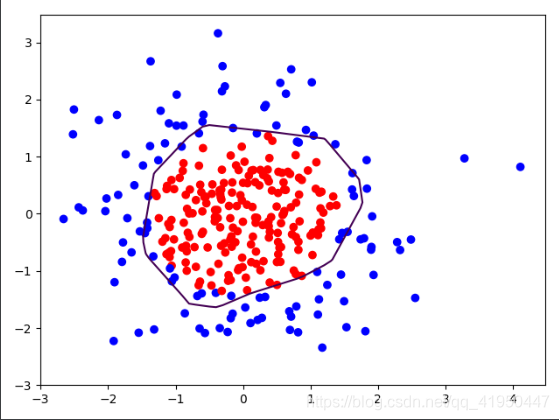正则化(Regularization)?是机器学习中对原始损失函数引入额外信息,以便防止过拟合和提高模型泛化性能的一类方法的统称。也就是目标函数变成了原始损失函数+额外项,常用的额外项一般有两种,英文称作?1?norm?1?norm和?2?norm?2?norm,中文称作L1正则化和L2正则化,或者L1范数和L2范数(实际是L2范数的平方)。
- L2正则化,拟合过程中通常都倾向于让权值尽可能小,最后构造一个所有参数都比较小的模型。因为一般认为参数值小的模型比较简单,能适应不同的数据集,也在一定程度上避免了过拟合现象。可以设想一下对于一个线性回归方程,若参数很大,那么只要数据偏移一点点,就会对结果造成很大的影响;但如果参数足够小,数据偏移得多一点也不会对结果造成什么影响,专业一点的说法是抗扰动能力强。
- 正则化参数λ越大,θj衰减得越快,最后求得代价函数最值时各参数也会变得很小,当然也不是越大越好,太大容易引起欠拟合。
使用逻辑回归的例子来解释正则化问题,给定一个数据集中又x1,x2,y在神经网络中进行训练,再用网格中坐标作为测试集测试,将原始数据x1,x2进行0/1分类,以图表显示
一.未使用正则化
1.Y_c = [['red' if y else 'blue'] for y in y_train]
用颜色来代替0/1预测值 [['red'], ['blue'], ['blue'], ['red'], ['red'], ['blue'],
2.h1 = tf.nn.relu(h1)
relu激活函数
3.xx, yy = np.mgrid[-3:3:.1, -3:3:.1]
xx在-3到3之间以步长为0.01,yy在-3到3之间以步长0.01,生成间隔数值点,最终xx,yy为60*60的矩阵,np.mgrid方法详见mgrid与meshgrid生成数据的区别以及与contour等高线的联系
4.xx.ravel(), yy.ravel()
ravel()方法是将xx,yy矩阵按行优先拉伸为一位数组
5. np.c_[xx.ravel(), yy.ravel()]
np.c_是将矩阵列数合并要求行数与原矩阵相同,np.r则列数相同,如果是一维数组的话,按两个数组的索引组成坐标对矩阵(shape为n*2)
6.color=np.squeeze(Y_c)
squeeze去掉纬度是1的纬度,相当于去掉[['red'],[''blue]],内层括号变为['red','blue']。如果没有维度为1的维度,则不发生改变。
7.plt.scatter(x1, x2, color=np.squeeze(Y_c))
将原始数据x1,x2形成散列点以坐标图像展示,并标上之前预设好的颜色。
8.plt.contour(xx, yy, probs,levels=[.5])
画分界线,数据以0/1分类,probs为每个坐标点的预测值(0~1之间),则将预测值为0.5的坐标画上分界线,此线也就是分类点的分界线。
代码清单:
# Alleviate overfitting缓解过拟合
# L2 正则化公式非常简单,直接在原来的损失函数基础上加上权重参数的平方和:正则化的目的是限制参数过多或者过大,避免模型更加复杂
# 导入所需模块
import tensorflow as tf
from matplotlib import pyplot as plt
import numpy as np
import pandas as pd
# 读入数据/标签 生成x_train y_train
df = pd.read_csv('dot.csv')
#将数据按标签 转换为矩阵x_data y_data
x_data = np.array(df[['x1', 'x2']])
y_data = np.array(df[['y_c']])
# print(x_data)
print(y_data)
#下面这一步其实是没有必要的,上面x_data与ydata已经是矩阵形式的了,没必要再通过reshape转为两列一列了,生成的数据其实是相同的
# reshape(-1, 2)转换为两列,reshape(-1, 1)转换为一列
#np.vstack(x_data)纵向堆叠数据,形成矩阵形式
x_train = np.vstack(x_data).reshape(-1, 2)
y_train = np.vstack(y_data).reshape(-1, 1)
print(x_train)
print(y_train)
# 用颜色区分0./1.数据
Y_c = [['red' if y else 'blue'] for y in y_train]
print(Y_c)
#用颜色来代替0/1预测值
#[['red'], ['blue'], ['blue'], ['red'], ['red'], ['blue'],
# 转换x的数据类型,否则后面矩阵相乘时会因数据类型问题报错
x_train = tf.cast(x_train, tf.float32)
y_train = tf.cast(y_train, tf.float32)
# from_tensor_slices函数切分传入的张量的第一个维度,生成相应的数据集,使输入特征和标签值一一对应
train_db = tf.data.Dataset.from_tensor_slices((x_train, y_train)).batch(32)
# 生成神经网络的参数,输入层为2个神经元,隐藏层为11个神经元,1层隐藏层,输出层为1个神经元
# 用tf.Variable()保证参数可训练
w1 = tf.Variable(tf.random.normal([2, 11]), dtype=tf.float32)
b1 = tf.Variable(tf.constant(0.01, shape=[11]))
w2 = tf.Variable(tf.random.normal([11, 1]), dtype=tf.float32)
b2 = tf.Variable(tf.constant(0.01, shape=[1]))
lr = 0.005 # 学习率
epoch = 800 # 循环轮数
# 训练部分
for epoch in range(epoch):
for step, (x_train, y_train) in enumerate(train_db):
with tf.GradientTape() as tape: # 记录梯度信息
# 第一层隐藏层
h1 = tf.matmul(x_train, w1) + b1 # 记录神经网络乘加运算
# 如果不用激励函数(其实相当于激励函数是f(x) = x),在这种情况下你每一层输出都是上层输入的线性函数,很容易验证,无论你神经网络有多少层,输出都是输入的线性组合。
# 激活函数是用来加入非线性因素的,提高神经网络对模型的表达能力,解决线性模型所不能解决的问题。
h1 = tf.nn.relu(h1)#激活函数
# 输入激活函数
y = tf.matmul(h1, w2) + b2
# 采用均方误差损失函数mse = mean(sum(y-out)^2)
loss = tf.reduce_mean(tf.square(y_train - y))
# 计算loss对各个参数的梯度
variables = [w1, b1, w2, b2]
grads = tape.gradient(loss, variables)
# 实现梯度更新
# w1 = w1 - lr * w1_grad tape.gradient是自动求导结果与[w1, b1, w2, b2] 索引为0,1,2,3
w1.assign_sub(lr * grads[0])
b1.assign_sub(lr * grads[1])
w2.assign_sub(lr * grads[2])
b2.assign_sub(lr * grads[3])
# 每20个epoch,打印loss信息
if epoch % 20 == 0:
print('epoch:', epoch, 'loss:', float(loss))
# 预测部分
print("*******predict*******")
# xx在-3到3之间以步长为0.01,yy在-3到3之间以步长0.01,生成间隔数值点
xx, yy = np.mgrid[-3:3:.1, -3:3:.1]
# 将xx , yy拉直,并合并配对为二维张量,生成二维坐标点
#ravel()将数组维度拉成一维数组
#np.c_将矩阵列数合并要求行数与原矩阵相同,np.r相反
#如果是数组,用np.c_是组成坐标对
#grid也就代表网格中所有的坐标点,为了给下面的坐标点赋值预测值,形成测试集
grid = np.c_[xx.ravel(), yy.ravel()]
print("xx.ravel()")
print(xx.ravel())
#ravel()将数组维度拉成一维数组
#[-3. -3. -3. ... 2.9 2.9 2.9]
print('=============================')
print(grid)
# print(grid)
# [[-3. -3. ]
# [-3. -2.9]
# [-3. -2.8]
# ...
# [ 2.9 2.7]
# [ 2.9 2.8]
# [ 2.9 2.9]]
grid = tf.cast(grid, tf.float32)
# 将网格坐标点喂入神经网络,进行预测,probs为输出
probs = []
for x_test in grid:
print(x_test)
# 使用训练好的参数进行预测
h1 = tf.matmul([x_test], w1) + b1
h1 = tf.nn.relu(h1)
y = tf.matmul(h1, w2) + b2 # y为预测结果
probs.append(y)
# 取第0列给x1,取第1列给x2
x1 = x_data[:, 0]
x2 = x_data[:, 1]
# probs的shape调整成xx的样子
print("probs")
print(probs)#这里打印的是每一个x_test的结果,x_test一共3600个
probs = np.array(probs).reshape(xx.shape)#xx.shape 60*60
print(probs)
print(probs.shape)#60*60
#将原始数据对生成散列图
plt.scatter(x1, x2, color=np.squeeze(Y_c)) # squeeze去掉纬度是1的纬度,相当于去掉[['red'],[''blue]],内层括号变为['red','blue']
#画出0/1 red/blue分界线
# 把坐标xx yy和对应的值probs放入contour函数,给probs值为0.5的所有点上色 plt.show()后 显示的是红蓝点的分界线
plt.contour(xx, yy, probs,levels=[.5])#给值为0.5的等高线画上分界线
plt.show()
# 读入红蓝点,画出分割线,不包含正则化
# 不清楚的数据,建议print出来查看
?通过此结果可以看出,分界线很曲折,过拟合,没有很好的模型泛化能力。

?二.使用L2正则化
为w1,w2添加了L2正则化
loss_regularization = []
# tf.nn.l2_loss(w)=sum(w ** 2) / 2
#简单的可以理解成张量中的每一个元素进行平方,然后求和,最后乘一个1/2
loss_regularization.append(tf.nn.l2_loss(w1))
loss_regularization.append(tf.nn.l2_loss(w2))
# 求和
# 例:x=tf.constant(([1,1,1],[1,1,1]))
# tf.reduce_sum(x)
# >>>6
loss_regularization = tf.reduce_sum(loss_regularization)
#正则化参数为0.03
loss = loss_mse + 0.03 * loss_regularization # REGULARIZER = 0.03代码清单:
# 导入所需模块
import tensorflow as tf
from matplotlib import pyplot as plt
import numpy as np
import pandas as pd
# 读入数据/标签 生成x_train y_train
df = pd.read_csv('dot.csv')
x_data = np.array(df[['x1', 'x2']])
y_data = np.array(df['y_c'])
x_train = x_data
y_train = y_data.reshape(-1, 1)
Y_c = [['red' if y else 'blue'] for y in y_train]
# 转换x的数据类型,否则后面矩阵相乘时会因数据类型问题报错
x_train = tf.cast(x_train, tf.float32)
y_train = tf.cast(y_train, tf.float32)
# from_tensor_slices函数切分传入的张量的第一个维度,生成相应的数据集,使输入特征和标签值一一对应
train_db = tf.data.Dataset.from_tensor_slices((x_train, y_train)).batch(32)
# 生成神经网络的参数,输入层为2个神经元,隐藏层为11个神经元,1层隐藏层,输出层为1个神经元
# 用tf.Variable()保证参数可训练
w1 = tf.Variable(tf.random.normal([2, 11]), dtype=tf.float32)
b1 = tf.Variable(tf.constant(0.01, shape=[11]))
w2 = tf.Variable(tf.random.normal([11, 1]), dtype=tf.float32)
b2 = tf.Variable(tf.constant(0.01, shape=[1]))
lr = 0.005 # 学习率为
epoch = 800 # 循环轮数
# 训练部分
for epoch in range(epoch):
for step, (x_train, y_train) in enumerate(train_db):
with tf.GradientTape() as tape: # 记录梯度信息
h1 = tf.matmul(x_train, w1) + b1 # 记录神经网络乘加运算
h1 = tf.nn.relu(h1)
y = tf.matmul(h1, w2) + b2
# 采用均方误差损失函数mse = mean(sum(y-out)^2)
loss_mse = tf.reduce_mean(tf.square(y_train - y))
# 添加l2正则化
loss_regularization = []
# tf.nn.l2_loss(w)=sum(w ** 2) / 2
#简单的可以理解成张量中的每一个元素进行平方,然后求和,最后乘一个1/2
loss_regularization.append(tf.nn.l2_loss(w1))
loss_regularization.append(tf.nn.l2_loss(w2))
# 求和
# 例:x=tf.constant(([1,1,1],[1,1,1]))
# tf.reduce_sum(x)
# >>>6
loss_regularization = tf.reduce_sum(loss_regularization)
#正则化参数为0.03
loss = loss_mse + 0.03 * loss_regularization # REGULARIZER = 0.03
# 计算loss对各个参数的梯度
variables = [w1, b1, w2, b2]
grads = tape.gradient(loss, variables)
# 实现梯度更新
# w1 = w1 - lr * w1_grad
w1.assign_sub(lr * grads[0])
b1.assign_sub(lr * grads[1])
w2.assign_sub(lr * grads[2])
b2.assign_sub(lr * grads[3])
# 每200个epoch,打印loss信息
if epoch % 20 == 0:
print('epoch:', epoch, 'loss:', float(loss))
# 预测部分
print("*******predict*******")
# xx在-3到3之间以步长为0.01,yy在-3到3之间以步长0.01,生成间隔数值点
xx, yy = np.mgrid[-3:3:.1, -3:3:.1]
# 将xx, yy拉直,并合并配对为二维张量,生成二维坐标点
grid = np.c_[xx.ravel(), yy.ravel()]
grid = tf.cast(grid, tf.float32)
# 将网格坐标点喂入神经网络,进行预测,probs为输出
probs = []
for x_predict in grid:
# 使用训练好的参数进行预测
h1 = tf.matmul([x_predict], w1) + b1
h1 = tf.nn.relu(h1)
y = tf.matmul(h1, w2) + b2 # y为预测结果
probs.append(y)
# 取第0列给x1,取第1列给x2
x1 = x_data[:, 0]
x2 = x_data[:, 1]
# probs的shape调整成xx的样子
probs = np.array(probs).reshape(xx.shape)
plt.scatter(x1, x2, color=np.squeeze(Y_c))
# 把坐标xx yy和对应的值probs放入contour函数,给probs值为0.5的所有点上色 plt.show()后 显示的是红蓝点的分界线
plt.contour(xx, yy, probs, levels=[.5])
plt.show()
# 读入红蓝点,画出分割线,包含正则化
# 不清楚的数据,建议print出来查看
?通过此图来看,添加了正则化的模型相比较未正则化的图像来说,此图分界线比较圆滑,又较强的模型泛化能力。

